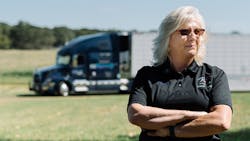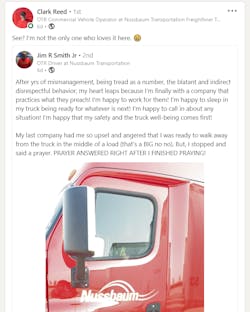It’s no question that driver recruitment and retention has been top of mind for the trucking industry and that driver capacity constraints are a growing concern. But to Shawn Kitchen, director of operations at True Load Time and former driver, recruiter, trainer, and fleet safety manager, there is no driver shortage.
“The industry doesn’t have a turnover problem, it has a retention problem,” explained Kitchen in a webinar sponsored by Transflo. “You have to be transparent with your drivers about the great things as well as the bad things.”
Kitchen explained that companies have to be willing to own up to the fact that there are good things about working at said company, but there are also not so good things. According to Kitchen, companies "need to explain to that person, that driver, that they are needed to help make things better.”
Kitchen was joined by Debra LaBree, driver and president at Castle Transport, as well as Verien Larsen, solutions architect at Transflo, to discuss how fleets can engage with their drivers and create better recruitment and retention relationships.
For LaBree, female drivers were not abundant when she started driving. So, she looked for those in the industry to whom she could relate, and she found them in the Women in Trucking Association (WIT).
“When I found WIT, I was able to find other women in the industry to share ideas with and encourage one another,” LaBree said. “When you’re in an industry like this that allows women to have such a great career, I want to help other women who come after me succeed. I stumbled through the dark when I first began, so they don’t have to. Good relationships help build good businesses.”
However, good relationships between company and driver can, at times, be challenging.
“I know from being very involved in the WIT Facebook page, there’s always more to the story when a driver says they leave,” LaBree explained. “We find it has a lot to do with dispatcher relationships and broken promises overall. So, when that trust is broken, drivers just want to leave and start fresh somewhere else.”
Kitchen explained that salary is a great scapegoat answer for people when leaving a company, no matter the industry. But for drivers, is pay the blanket answer?
“Salary masks the fact of why drivers leave,” Kitchen said. “Our success rises and falls based on the relationships we have with the people around us. When you enter a company, you enter at a certain level of trust, but that trust can be very easily and very quickly eroded by recruiters who aren’t giving full disclosure, and dispatchers who are poor communicators or aren’t very skilled at keeping trucks moving. All these different things lead to a loss of income. That dollar figure ends up being the physical manifestation of all the other problems drivers are having. It’s hard to point the finger at one specific thing. It’s an umbrella term for several other problems that are happening behind the scenes.”
Larsen believes that checking in with drivers can help bridge that relationship gap.
“Something like a driver survey is a simple thing to do to check in with your drivers to see how they’re doing, get their input and feedback to see where we can improve,” Larsen explained. “Technology is so common nowadays, and this method can be seamlessly conducted at their convenience. The important part is once you receive this feedback is to act on it. That will tell your drivers that you’re actually listening, and that you care.”
Kitchen believes the strategy is hidden in plain sight—drivers.
“If you guys aren’t following Clark Reed on LinkedIn, you need to,” Kitchen said. “Reed is a company driver for Nussbaum Transportation. Now, I don’t know what they’re putting in the water over there, but they are using technology between a driver and fleet to help elevate the company’s perception, which can be a really great tool for driver morale.
“Reed’s big thing is fuel economy,” Kitchen explained. “He uses the technology in his truck to monitor his fuel economy, and I love the way his company is supporting him on social media and allowing him to become a brand ambassador. There’s a lot of untapped ground in this kind of strategy. If you’re a carrier and you don’t know who the 1% of your top drivers are, look at the tools at your disposal. If you’re savvy, you can utilize those halo drivers as a public face to become a driver morale tool. We all desire to be a part of something successful, something that encourages us to excel. Clark and Nussbaum are a great case study in what positive work can be done when you’re successful in bringing together those positive relationships.”
Kitchen also explained how some companies take this “driver scorecard” and use it in the exact opposite way it should be.
“When we talk about a driver scorecard, there’s a difference between a carrot and a stick,” Kitchen said. “I’ve seen plenty examples of a company who will use at that information of the driver scorecard and go after the poor performing drivers. We all need accountability, but as a driver, if the first time you’re spoken to by someone in your company and get beat up about how bad you’re performing, that driver is going to look at all further communication with a negative association.
“With this strategy, you’ve already broken the relationship with your driver with a stick,” Kitchen added. “Instead, build a better relationship with a carrot. As Larsen said, ask the driver how they’re doing, what’s going on in their life. Building that relationship will communicate to your driver that you truly care about them and then, their performance has the opportunity to improve.”
About the Author
Catharine Conway
Digital Editor
Catharine Conway is a past FleetOwner digital editor who wrote for the publication from 2018 to 2022.


